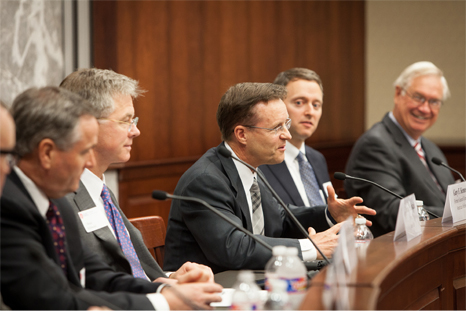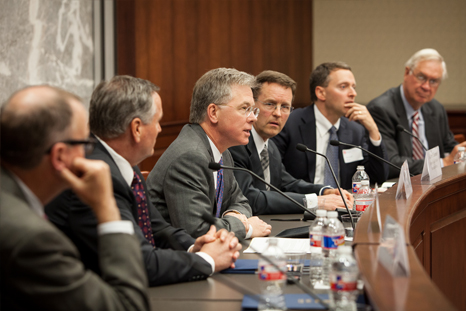© 2014 The Texas Lawbook.
By Natalie Posgate and Mark Curriden – (June 26) – Then-American Airlines General Counsel Gary Kennedy was climbing the six flights of stairs at the airline’s headquarters when he received a text message giving him bad news about the merger with US Airways.
Just about nothing had gone as expected since the Fort Worth-based airline filed for bankruptcy in November 2011.
The company filed for Chapter 11 protection in the Southern District of New York instead of North Texas because the bankruptcy judges there had more experience handling large, complex corporate reorganizations. However, the American Airlines case was assigned to a newly-appointed judge who had almost no such expertise.
Kennedy promised his CEO and board of directors that the Chapter 11 process would be fast and furious but over quickly.
“Obviously, it didn’t work out that way,” Kennedy told an audience of more than 100 business lawyers and corporate general counsel Tuesday evening at SMU Dedman School of Law. “The bankruptcy and merger was 24 hours a day, seven days a week. There were conference calls at all hours and everyone on our legal team was expected to be constantly on call.”

All photos by Brittany Oswald
US Airways strategically forced its way into the bankruptcy proceedings by proposing it merge with American – a merger that AA officials initially opposed but then accepted.
Meanwhile, legal fees were mounting at an astonishing rate.
“We were, at the peak, paying $500,000 a day,” Kennedy said. The final legal tab would exceed $250 million. The funny thing about bankruptcy and the costs to solve it, he added, is, “you’re a debtor, yet everyone is eating on this carcass that’s here.”
Kennedy says he told his CEO and board that his lawyers internally and externally assured him that the proposed merger with US Airways would face no obstacles from regulators.
“The one thing we were told was, we’d have no antitrust problems [from the U.S. Department of Justice],” Kennedy said at the CLE program hosted by The Texas Lawbook, the General Counsel Forum and the SMU Dedman Law School.
But on Aug. 13, 2013, as Kennedy ascended the stairway at AA HQ, he received a text message from his top outside lawyer at Jones Day.
“Justice and Texas AG are filing.”
“I said some words I shouldn’t have,” Kennedy said. “It was a very long walk up three more flights to the sixth floor offices of our CEO.”
Kennedy said they immediately got on the phone with the board and the board members were very upset.
“It made for a very bad day,” he said. “We thought we had the deal done. It almost killed the deal entirely. All of a sudden, it’s not anywhere near done.”

Kennedy and a half-dozen other in-house and outside counsel who were instrumental in the American Airlines bankruptcy, the merger with US Airways and the subsequent antitrust battle with the U.S. Department of Justice provided the audience at SMU Dedman with an amazing behind-the-scenes tour of the historic reorganization.
Senior in-house corporate counsel for American Airlines, US Airways and key lawyers from Weil, Gotshal & Manges and Jones Day provided the most extensive insider’s view to date on the legal strategies and the obstacles they faced. SMU Dedman video recorded the 90-minute CLE program.
Don Erickson, a valuation expert, president of Dallas-based Erickson Partners and an independent M&A advisor, described the American restructuring as “the most successful corporate bankruptcy in U.S. history.
“At the end of the day, if you can get 80 or 50 cents to the dollar, it’s good. Here you got 105 [cents] on the dollar,” said Erickson, pointing out the fact that American’s creditors were paid in full.
Erickson, who was not involved in the American Airlines matter, pointed out that American’s stock price dropped to 30 cents a share the day the company filed for bankruptcy protection in November 2011. The stock closed Wednesday at $44 per share.
Kennedy started the evening by telling the audience he flew undercover on Delta Airlines to New York the night before the bankruptcy filing so that pilots, flight attendants and other American Airlines employees wouldn’t spot him and get suspicious.
Kennedy, who survived three CEOs during his 20-year career at American, said the airline’s financial struggles began when 9/11 occurred, but American spent a decade fighting to stay out of bankruptcy before saying “enough is enough.”
Though a bankruptcy court is located right in American’s backyard, Kennedy decided to file for Chapter 11 in the Southern District of New York because the judges there have significantly more experience in large, complex bankruptcies and because the company feared that thousands of AA employees would invade the courtroom if the company had filed in Fort Worth.
Ironically, the New York judge assigned to American’s case was a brand new appointee, but Kennedy said Judge Sean Lane still “did a great job.” In hindsight, he does “kind of wish we had filed in Tarrant County.”
Another justification for the filing in New York had to do with the fact that American hired some of the best bankruptcy attorneys in the country at Weil, Gotshal & Manges, which is based in New York.
“At any given moment, we had maybe 100 lawyers working on (the bankruptcy),” said Glenn West, a Weil partner based in Dallas who was the lead lawyer in the merger with US Airways.
“Well, you billed us for 102,” Kennedy teased, in a lighter moment.
“Then it was 102 lawyers,” West responded to laughter.
West pointed out that bankruptcy has become so expensive that, ironically, poor companies or businesses with no cash cannot afford to go through the procedure.
West, who has been the lead lawyer in at least five billion-dollar-plus mergers and acquisitions during the past two years, walked the audience through the complex and yet highly successful structure he and other lawyers developed using preferred and non-preferred shares of stock to meet the company’s obligations to creditors.
“I wish I could take credit for the success, but we have a lot of very smart people working for us,” West said.
West mentioned the talks with US Airways were complex because so many parties were involved. When one set of lawyers would reach an agreement on a certain matter, another set of American lawyers would jump in to say that the bankruptcy judge would never approve that agreement. That, in turn, frustrated lawyers with US Airways who contended that they already reached an agreement.
“It’s much different from any M&A transaction,” he said.
Meanwhile, US Airways had its eye on a merger with American, said Howard Kass, who was an assistant general counsel at US Airways and a key lawyer in the merger discussions with American.
“We dissected their network inside and outside, and looked at where US Airways was,” said Kass, who is now senior vice president for regulatory affairs and a senior leader in the new American’s corporate legal department.
“The sum of these two carriers puts together something on par with the two other leading airlines,” he said. “When you put us together, we’re No. 1 on the East Coast and Midwest and No. 3 on the West Coast.”
But the DOJ had something else in mind. In August, the federal government and six states, including Texas Attorney General Greg Abbott, sued to block the merger.
American Airlines Associate General Counsel Bruce Wark and Jones Day partner and antitrust expert J. Bruce McDonald said they were flabbergasted by the lawsuit – especially Abbott’s involvement, which Wark called a “wildcard.”
McDonald said American and US Airways had an aggressive strategy: to get to trial with the DOJ as soon as possible. The DOJ wanted a much later date than the airlines, he said, but the judge fortunately granted a trial date near Thanksgiving.
“We were very focused on making sure we were ready to try the case,” Wark said.
Wark and McDonald said they could not understand Abbott’s reasoning for opposing the merger, especially when the new airline would be based in Texas and especially after Abbott had not objected to Continental’s merger with United, which led to Texas losing the company’s headquarters to Chicago.
Wark said that he and Kennedy traveled to Austin early to meet with Abbott’s staff, during which “they obviously realized they made a mistake” by joining the lawsuit.
When the moderator noted that Attorney General Abbott basically agreed to settle his case for essentially no additional substantive concessions, Kennedy and Wark laughed.
“It was not the toughest settlement I’ve ever negotiated,” both men agreed.
As for how the company is currently doing, Wark said it has seen some of its best days in the past six months.
“We’re making more profits than we ever have,” he said.
© 2014 The Texas Lawbook. Content of The Texas Lawbook is controlled and protected by specific licensing agreements with our subscribers and under federal copyright laws. Any distribution of this content without the consent of The Texas Lawbook is prohibited.
If you see any inaccuracy in any article in The Texas Lawbook, please contact us. Our goal is content that is 100% true and accurate. Thank you.
